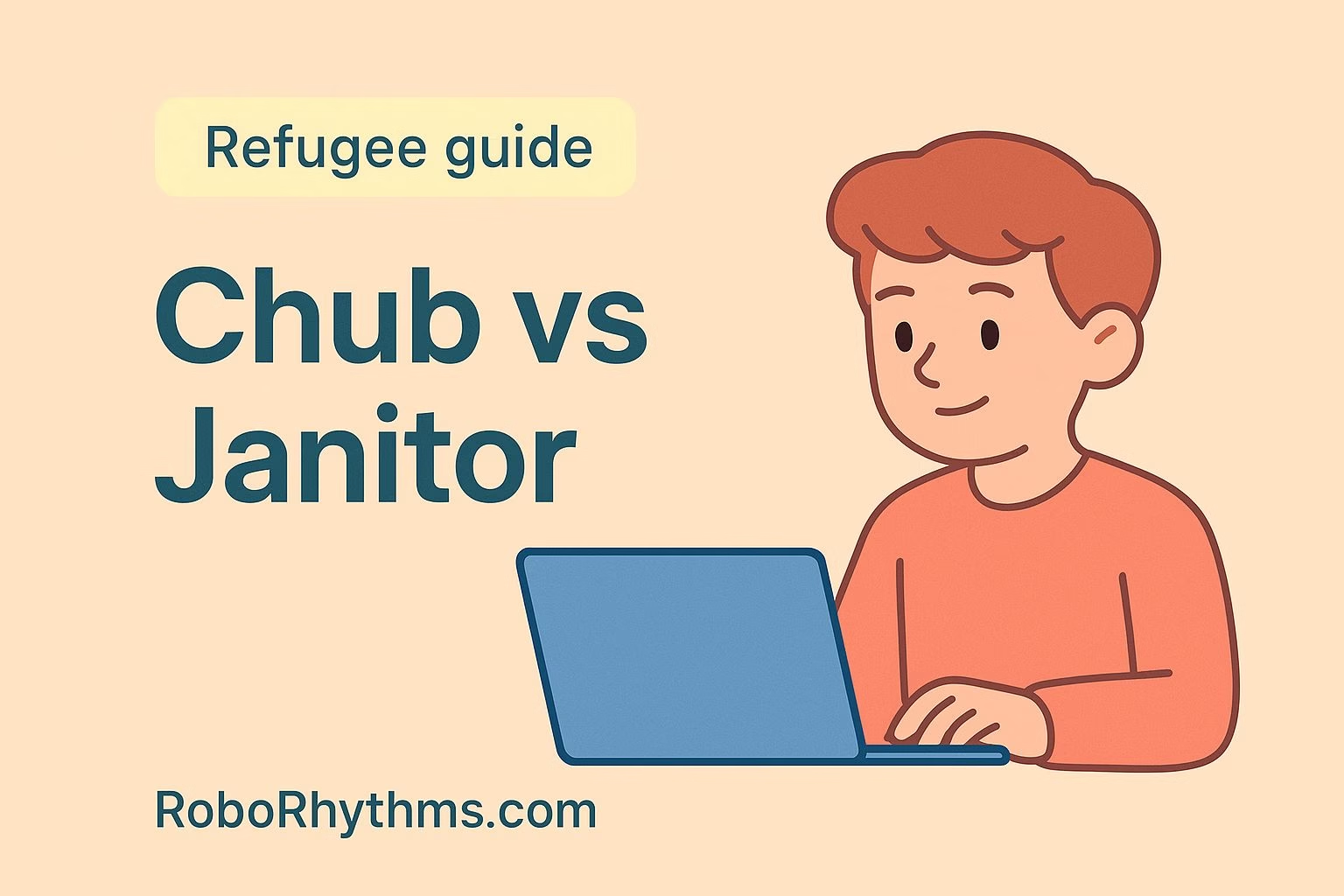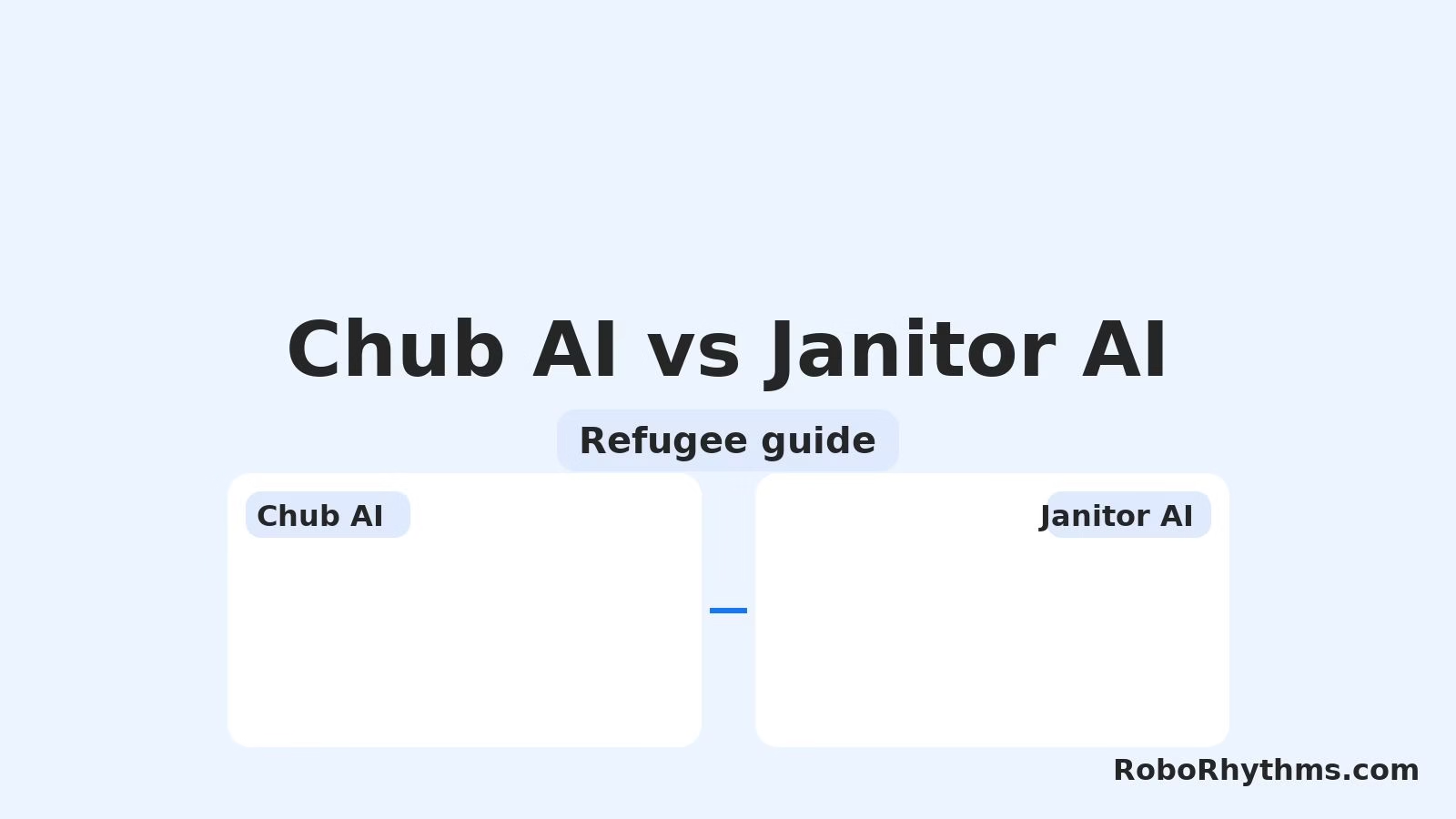Chub AI vs Janitor AI what refugees need to know before switching
Switching from Janitor AI to Chub AI:
- Text feels freer. Images face tighter checks. Keep public avatars clean.
- Use one paid daily driver model and a free route for tests. Keep two backups.
- Pin a short scene note. Recap every 12–20 turns for long chats.
- Import cards, keep starters 350–500 words, add a small repair cue.
- Store core prompts offline, use unique email and 2FA, rotate external links.
We have seen a steady flow of Janitor AI users trying Chub AI after outages, paywalls, or policy shifts.
If you are thinking about moving, you need a clear picture of what actually changes on day one. We focus on what you can do without friction, what breaks your current routines, and what setup steps save time. No fluff. Just what matters when you switch.
We compare model access, rate limits, and how fast chats feel when traffic spikes. We look at NSFW rules, bot discovery, memory, and how well long chats stay coherent.
We also cover privacy, account security, and whether your chats are stored or used for training. If you build or tweak bots, we note import options, jailbreak behavior, and prompt controls that affect output quality.
We do not chase features that sound cool but you will never use. We highlight what affects your daily chats, your roleplays, and your custom bots.
If you want a backup plan, we also mention steady alternatives you can test in parallel, so you are never locked in.
Ready for the breakdown that matters for refugees moving from Janitor AI to Chub AI?
| What you care about | Chub AI | Refugee note |
|---|---|---|
| Model access and speed | Text feels fast on paid routes. Free can slow at peak. | Pick one paid “daily driver” and keep a free route for tests. |
| Long chat memory | Good, but needs scene notes and short recaps. | Pin a scene note and recap every 12–20 turns. |
| NSFW and images | Writing is flexible. Images face tighter checks. | Keep public avatars clean. Host sensitive sets off platform. |
| Bot import and edits | Card import works. Live prompt edits save time. | Start with a 350–500 word starter and a repair preset. |
| Privacy and data | Treat hosted chats as logged for safety and uptime. | Use unique email, 2FA, and keep prompts offline. |
| Traffic spikes | Paid holds better during rush hours. | Keep backups on Candy AI or CrushOn AI. |
| Publishing workflow | Unlisted testing, neutral previews. | Test edge cases, then list public when stable. |
What changes on day one when you switch
Chats on Chub AI feel freer in text. Image features face tighter checks. If your use is text heavy, you gain flexibility right away.
If you rely on image avatars or galleries, expect more flags and plan safe previews first.
Live editing is a time saver. You can tweak a bot’s starter or traits during a scene. This reduces hard resets and keeps tone steady.
Character cards import cleanly, so your core prompts travel with you.
Paid routes help during peak hours. Free stays useful for quick tests. Start with one paid route for your daily driver bot, then trial a second model for backups.
Keep your core prompts in a local doc for fast copy and paste.
-
Keep a clean public avatar and cover.
-
Import cards, then tighten starters and lore.
-
Use one paid route as the daily driver.
-
Run quick tests on free before big scenes.
-
Store core prompts locally for fast edits.
What breaks from Janitor AI routines
Long chat recall feels shorter. Scenes drift if you do not restate facts. Add a brief scene note at the top and recap key details every few turns.
This keeps continuity without long rewrites.
Image tolerance differs from what you had. Writing is open, but art has stricter rules. If visuals are central, keep spicier sets off platform and link only when needed.
Public pages should stay neutral and safe.
Traffic spikes change pacing. Free routes slow first. Paid holds better.
Share bots as unlisted while you tune tags and starters.
-
Pin a short scene note for continuity.
-
Recap names, goals, and limits every few turns.
-
Keep sensitive art off platform and link sparingly.
-
Test unlisted before going public.
-
Maintain a backup tool to avoid stalls.
Speed, rate limits, and model picks that feel good
You want chats that feel instant and stable during peak hours. Free routes slow first, so plan your main scenes on one paid route and keep free for quick tests.
Switch models when traffic spikes. Some handle load better than others.
Start with a single “daily driver” model and keep two backups. Use the driver for long scenes, one backup for rough drafts, and the other for fast retries.
Rotate when replies start drifting or lagging. This lowers frustration and keeps flow.
Track your own ceiling. If you hit rate limits often, your workflow needs smaller messages and fewer retries.
Shorten turns, summarize every few exchanges, and retry only when meaning changed, not wording.
-
Pick one paid route for the main bot.
-
Keep a free route for smoke tests.
-
Save three preset prompts labeled: scene, repair, fast.
-
Rotate models when latency rises or tone drifts.
-
Log slowdowns with time and model to spot patterns.
NSFW rules, images, and how to stay safe
Writing is flexible, but images face tighter checks. Treat avatars and galleries as the public face.
Keep any spicier art off the platform and only reference externally when needed. This keeps your account safe and your scenes uninterrupted.
Split creative from public. Run private tests first, then publish a cleaned version with safe tags and neutral preview art.
If a flag appears, adjust tags, crop suggestive frames, and keep character descriptions focused on personality rather than body details.
If you must keep momentum during image blocks, switch to text-only cues and continue the scene. Reintroduce art after the session using links that you control.
-
Use a clean avatar and neutral cover art.
-
Test scenes privately before listing a bot.
-
Keep external links for sensitive galleries.
-
Tune tags and crops to reduce false flags.
-
Keep one text-only flow as a safe fallback.
Privacy, data storage, and account safety differences
You want clarity on what gets saved, who can see it, and how to protect your account. Treat any hosted platform as a place where logs can exist, at least for abuse prevention and uptime.
Keep sensitive scenes and identities separate. Use unique emails and a strong password manager. Turn on 2FA if offered and keep one clean public profile even if you experiment privately.
Assume models may learn from aggregated patterns unless a provider states the opposite. Keep your high-value prompts locally.
If you need to wipe something, delete the bot, clear chats, and verify the export is gone. Keep an offline archive of your best starters and lore so you can rebuild fast.
If you ever link external media, control the folder on your side. Rotate links when you retire a scene. This reduces footprint and keeps flagged items from affecting your main account.
-
Use a unique email, strong passwords, and 2FA.
-
Export and store core prompts offline.
-
Delete bots and chats you no longer need.
-
Control external media links and rotate when retiring scenes.
Comparison
| What you care about | Janitor AI | Chub AI | Candy AI | Nectar AI |
|---|---|---|---|---|
| Model access and speed | Varies by route and load | Paid routes feel faster at peak | Consistent daily driver option | Stable performance for long chats |
| Long chat memory | Needs frequent recaps | Works best with pinned scene notes | Good continuity with short summaries | Reliable recall when prompts stay tight |
| NSFW and images | Policy fluctuations reported | Writing flexible, images stricter | Roleplay-friendly text focus | Text first, safe previews recommended |
| Bot import and edits | Cards import with tweaks | Live edits save time mid-scene | Simple setup for daily use | Clear starter plus repair cue works well |
| Privacy and data | Treat chats as logged for safety | Keep prompts offline and use 2FA | Use unique email and local backups | Rotate external links for sensitive media |
| Best use case | Existing routines if stable | Refugee daily driver with live tweaks | Parallel backup to avoid stalls | Long sessions with steady tone |
Building or importing bots without losing quality
Character cards import cleanly, but performance hinges on your starter, style rules, and a short lore block.
Keep starters under 350–500 words, define tone, limits, and refusal rules, then add a tiny recap line the bot can reuse. Pin a scene note for the user side so continuity survives model swaps.
Test replies on three sample prompts before you publish.
Jailbreak behavior differs from Janitor AI. Instead of stacking jailbreak text, bake behavior into the starter, then guide with user cues.
If replies drift, apply a small “repair” message and continue. Avoid heavy rewrites mid-scene. Adjust the starter between sessions, not during a climax, so voice stays steady.
Share unlisted first. Ask two testers to push edge cases and report failure modes like repetition, over-politeness, or broken boundaries. Fix the smallest thing that solves the problem, then try again.
When you list publicly, keep preview text neutral and art safe so discovery is smooth and flags stay rare.
-
Keep starters concise with tone, limits, and a recap line.
-
Use a light repair cue when drift appears.
-
Test unlisted with edge-case prompts before listing.
Long-run chat coherence and memory tactics
Coherence drops when scenes run long. We keep a living scene note at the top with names, goals, boundaries, and time skips.
Every 12 to 20 turns, we add a one-line recap so the model stays anchored without reading the full log.
Shorten turns. Dense, multi-action prompts cause drift. We feed one clear action and one emotional beat per message.
When the voice slips, we send a tiny repair cue that restates tone, limits, and current objective, then continue.
Keep lore compact. A tight 200 to 400 words works better than a long essay. If a detail is crucial, repeat it in the user side as a reminder.
This doubles reliability across model swaps and late-night sessions when latency rises.
-
Keep a pinned scene note with names, goals, and limits.
-
Add a one-line recap every 12 to 20 turns.
-
Use small repair cues instead of rewrites.
Migration checklist for Janitor AI refugees
We start with a clean export. Save your favorite starters, style rules, and two sample chats in a local folder.
Import the character card into Chub AI, paste the starter, and create a neutral preview that will never trigger a flag on discovery pages.
Create three presets. Daily driver, fast draft, and repair. The driver handles the main scenes. Fast draft is for brainstorming and retries.
Repair is a short message that restores tone and consent rules after drift. Test each on the same three prompts and compare replies.
Publish unlisted first. Run two full sessions and note slowdowns, repetition, and refusal patterns. Fix one thing at a time. When stable, list the bot and keep external art in your own folder.


